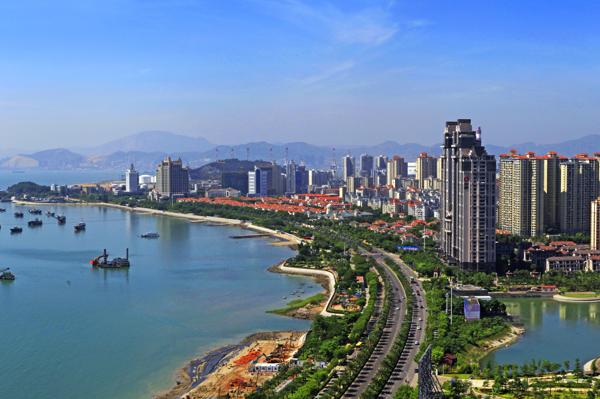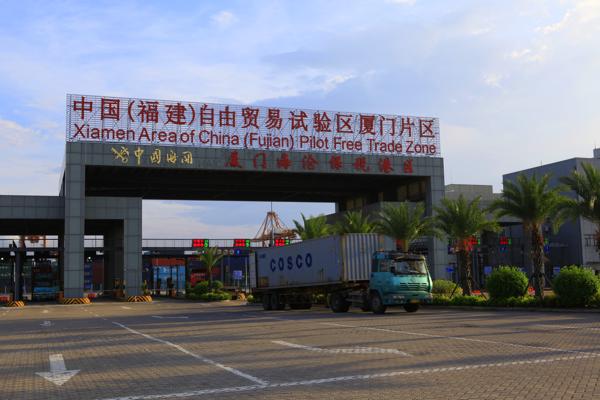
Haicang Bay. The district in Xiamen, Fujian province, is close to Taiwan both geographically and business-wise.[Photo by Zheng Weiming/China Daily]
The district of Haicang is winning favor with investors both domestically and from overseas and witnessing robust growth as it aims to create a first-class business environment for international investment and build itself into a leading example of industrial upgrading.
-k4YF-U101372738978gPD-600x400@English.gov.cn.jpg)
[Photo/China Daily]
In particular, the cluster of emerging industries is becoming a powerful new force to drive the industrial transformation and upgrading of the district, part of Xiamen, Fujian province.
A number of such industries have taken root in the area recently, such as a tariff-free display and trade center for imported commodities established by Tempus Group, a high-end commercial services provider in China; a manufacturing base built by AAC Technologies holdings; the Xiamen Grain Trade Center; and a sunflower seed oil project backed by Taiwan’s Standard Foods.
Favorable policies
On Aug 4, Taiwan’s Standard Foods signed a contract with the government of Haicang for a project that is expected to produce 200,000 metric tons of refined edible sunflower seed oil annually. Construction of the 150-million-dollar project will start in September and production of the oil is scheduled to start within a year.
-k4YF-U101372738978WCE-600x400@English.gov.cn.jpg)
[Photo/China Daily]
The successful establishment of the project in the Haicang section of the Fujian Pilot Free Trade Zone was largely due to preferential policies adopted in the zone, such as a “negative list” management approach for foreign investment. Investment in areas on the list is either prohibited or restricted, but those not listed only need inform authorities rather than apply for approval before setting up a business in the zone.
Previous polices required overseas investors to find Chinese partners to join edible oil processing projects on the Chinese mainland, with the Chinese investors holding a majority of the shares.
With the negative list, such projects can now operate with solely foreign investment in free trade zones, which brings new investment opportunities for the industry.
Because of such advantageous policies, Standard Foods plans to transfer its South China headquarters to Xiamen.

[Photo/China Daily]
The Standard Foods project exemplifies the advantages of the free trade zone in Haicang. Many other innovative measures adopted at the tariff-free zone have benefited Xiamen residents and businesses.
For example, businesses that display and trade products in Haicang’s tariff-free zone pay deposits daily instead of monthly according to a new electronic management mode adopted by Xiamen Customs. This measure has reduced business costs and helped companies save about half the interest on the deposits, and won acclaim from the businesses concerned.

[Photo/China Daily]
Haicang, which enjoys multiple advantages due to its status as a special economic zone, a major destination for Taiwan investment, a tariff-free port area and a pilot free trade zone, has always tried to develop through reform, the local government said. It will continue to create a business operation system that adopts international rules and standards to improve its environment for innovation.
Transformation benefits
The Cross-Straits information Consumption Research institute was recently established in Haicang. This is the first investment project in a free-trade zone in China by China Hualu Group, a leader in intelligent transportation.
The institute, with registered capital of 100 million yuan ($15.7 million), is expected to attract other companies in the information industry to the district. It will provide services to the Xiamen government, including advice, training and international communications, and participate in the development of Haicang in areas such as information technology and the Maluanwan new town project.
Other projects similar to the institute have been competing to enter Haicang and such projects are also driving the development of the district as an area led by innovation and new industries.
Huazhong university of Science and Technology signed an agreement with Haicang in July to help Haicang with its transformation. In April, a research institute that blends military and civilian technologies, established by the Xiamen government, the national university of Defense Technology and China Electronics, was established in the district. The institute will focus on the latest technologies, such as artificial intelligence, and is expected to serve as a new engine to upgrade Haicang.
In January, Tsinghua university also pledged to cooperate intensively with Haicang in a range of areas, such as mobile Internet, mass data and intelligent industries.
Attractive to Taiwan
“We will build Treasure island Dream Factory-an entertainment park that comes from Taiwan-here,” said Zeng Yizhan, CEO of a creative culture company in Taiwan. “The park will provide one-stop diversified sightseeing to visitors.”
Zeng is one of many who have started businesses in a startup base in Haicang aimed at young entrepreneurs from across the Straits.
“Haicang is a hotbed for emerging industries and I find its investment environment very attractive,” he said.
Haicang is the earliest established and largest area for investment from Taiwan in China. During the China international Fair for investment and Trade held in Xiamen in September every year, Haicang attracts many business people from Taiwan wanting to set up businesses in the district. A number of projects aimed at attracting investment from Taiwan, such as the business startup base, have been set up in Haicang recently and are attracting more enterprises from across the Straits.
Recently, Xiamen Customs and the Haicang government signed a deal to push forward the development of the pilot free trade zone. Subsequent measures will include deepening exchanges between the customs departments of Xiamen and Taiwan and encouraging Haicang port to have closer contact with major ports in Taiwan.
Rail line links Xiamen and Europe
The first service on an express railway connecting Xiamen and Europe departed from Haicang district on Aug 16.
The railway line starts from Haicang, Xiamen, in the Fujian Pilot Free Trade Zone and extends westward, passing through China’s western areas including Chengdu and Xinjiang, and then Kazakhstan, Russia and Belarus before ending in Poland. It takes 15 days for a train to complete the entire journey on the line, which is more than 10,000 kilometers long. This is 20 to 25 days less than by sea, and costs 80 percent less than air transport. For the time being, the train is scheduled to run once every week.
The most important reason that Haicang was chosen as the starting point of the railway is that the district is a core port area in southeast China. The size of the Haicang pilot free trade zone accounts for more than half of all the free trade zone area in Xiamen, and the district enjoys great advantages in industrial development and communications with Taiwan.
Xiamen, Chengdu and concerned parties in Europe have agreed to jointly build a transfer center for European goods in Haicang, and a similar center in Lodz, Poland, with free trade functions to ensure better operation of the railway. The two centers will become platforms for direct purchasing, marketing and distribution for major global commodities and benefit both businesses and consumers in both locations.
